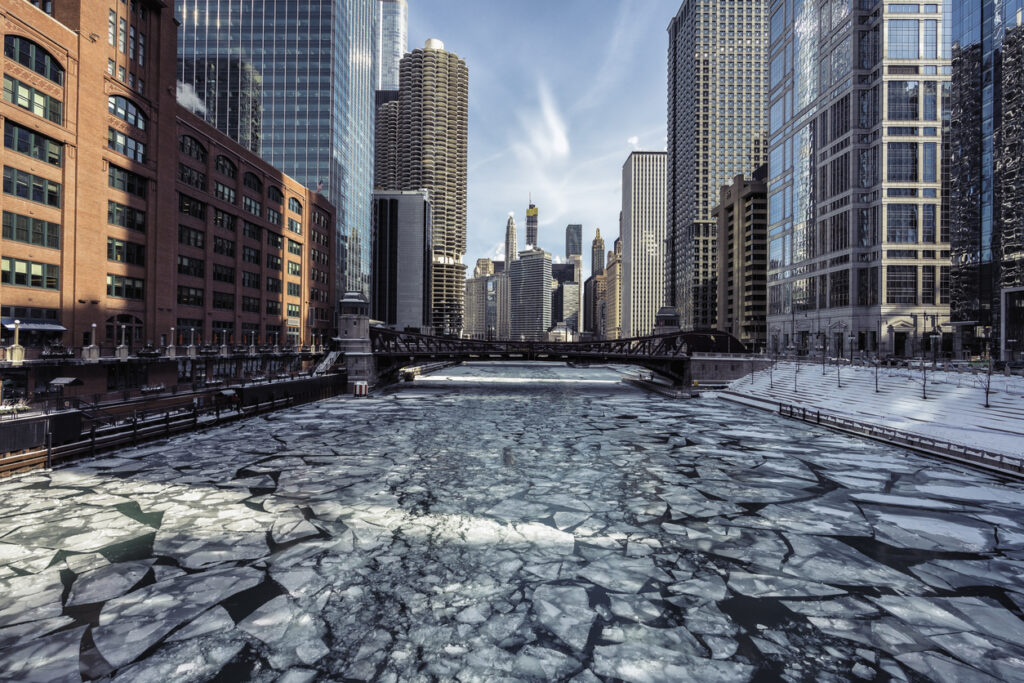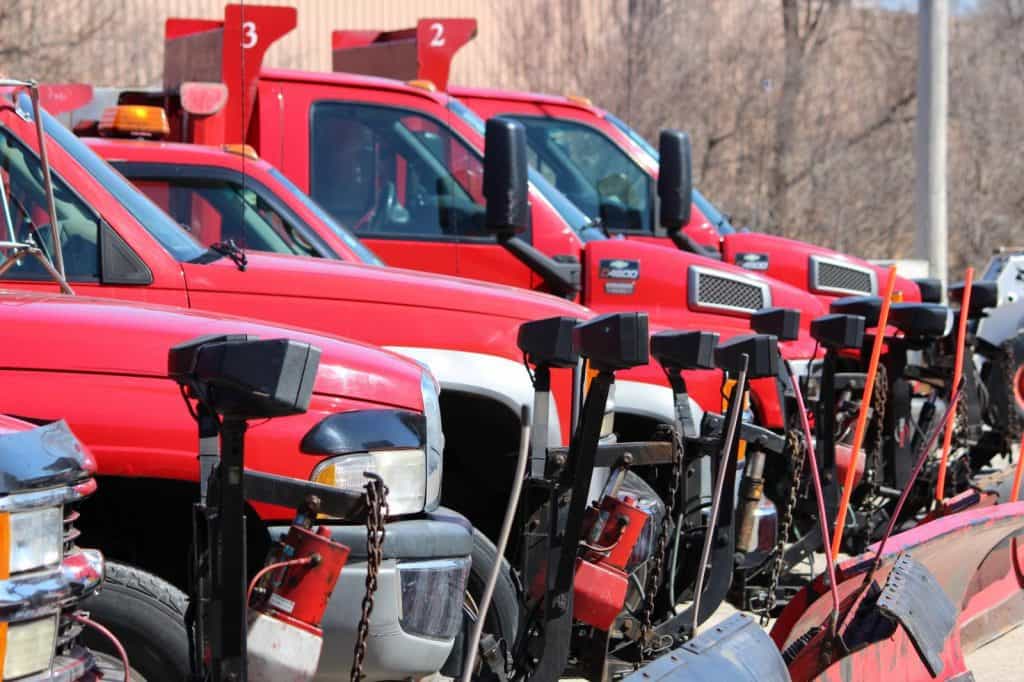The Chilling Reality of Chicago Winters and Snow Removal in Chicago
Snow Removal in Chicago is a harsh reality that its residents cannot ignore. When it comes to winter, Chicago is a city that truly feels the freeze. The city’s winters are infamous for their bone-chilling temperatures and heavy snowfall, making snow removal in Chicago a crucial task to keep the city moving. In this post, we will discuss the extreme weather that affects the Chicago metro area and explore the geography that makes those extremes possible.
Geography Complicates Chicago Winters
Three aspects of Chicago’s geography affect its weather year-round. Understanding how these features impact the weather individually and in concert with each other is important. Any one of them can affect the climate, but together they have a powerful impact on Chicago.
The biggest geological feature is Chicago’s location in the middle of the continent. The broad plains surrounding it extend to the west to the Rocky Mountains, northwest to the lake region of Alberta and Saskatchewan, and southwest to the Texas Panhandle. In the winter, intense cold from the northern polar region periodically moves quickly across the Great Plains. These storms, called “Alberta Clippers”, regularly drop temperatures 30 degrees or more. The accompanying wind is frequently 35-45 MPH, causing a wind-chill effect and dropping temperatures into the -30 to -50 degree range.

The Lake Effect
To the north of Chicago lies Lake Michigan. The effect of the lake is to moderate temperatures in both the summer and winter. In the summer the lake tends to cool the city with winds blowing across the water into the downtown area. Conversely, in the winter the water in the lake can be warmer than the air temperature around it. This has a warming effect on the winds blowing into the city, moderating the cold Midwestern temperatures.
However, winter storms that move into the lake region can create a weather phenomenon known as “lake-effect snow”. This is caused as arctic air moves across the warmer, moist air rising from the lake. As the moisture interacts with the polar air it produces significant snowfall. Combined with polar air and windchills, this phenomenon can contribute to the cold by adding significant snow and ice to a storm.
Urban Canyons and Weather
The final major geographical feature is the urban landscape. The blacktop, concrete, and steel combine their natural ability to absorb and hold heat. In the summer this effect, called the urban heat island (UHI) effect, causes temperatures in the city to be higher than in surrounding rural areas. This effect is more noticeable during the summer but can also impact winter temperatures to some extent by slightly mitigating extreme cold.

Urban geography can also produce a wind phenomenon based on something known as the “Venturi effect.”, named after Giovanni Venturi. Venturi posited that fluid acts to maintain the same rate of flow in a channel, even if that channel suddenly narrows. When the channel narrows the fluid will move more quickly to move the same amount of the fluid. Air moves in a similar fashion to fluid. The effect of streets lined with skyscrapers and other large buildings is to cause the wind to move more quickly through the narrowed geography.
This effect is amplified by the “downdraught effect.”. Simply put, when winds at higher altitudes strike a skyscraper, they will move down the building until they reach street level. At that point, they will be impacted by the high winds along the ground level. These phenomena work together to intensify the winds of an Alberta Clipper or similar storm.
Understanding Chicago’s Winter Climate
The geography of Chicago is complex and each feature impacts the others. Chicago’s location certainly helps it throughout the year. The heat of the summer is tempered by its more northern orientation and the cooling of the enormous Lake Michigan. The winters are moderated by the same lake, in spite of the threat of lake-effect snow. Unlike its more northern counterparts, the Chicago metro area is far enough south to not be affected by prolonged exposure to polar winds. Nonetheless, Chicago’s winters can be brutal!
Winter in Chicagoland is marked by significant cold and snow. The city experiences an average winter temperature of around 26°F. January is the coldest month, often seeing temperatures plummet to an average low of 18°F. However, these averages do not fully capture the extremities that can occur, such as the record low of -27°F recorded on January 20, 1985. These frigid temperatures, combined with the notorious “Windy City” gusts, can make the weather feel even colder.

Historical Winter Records and Their Impact
Chicago’s winter weather has set several records over the years. In January 1985, the city saw its coldest record temperature of -27°F. When they factored in wind chill, the temperature dropped to -78°F. That wasn’t the coldest wind-chill temperature ever recorded, however. That record goes to December 24, 1983, when the wind drove the temperature down to -82°F. Some experts say that those extremes might not be the lowest it has gone. Until 1970 the official weather station for Chicago was at Midway International Airport. That year it was moved to O’Hare International Airport, which is normally a few degrees cooler since it is located further from the city center. It is possible that earlier readings could have been record-setting at the O’Hare location.
Those winter records give a snapshot of the extremes that complicate snow removal in Chicago. But that doesn’t give us a complete picture. For instance, in the winter of 1976-77, there were 43 days with temperatures remaining below freezing. Those bone-chilling readings would be bad enough, but they were accompanied by over 54 inches of snow. Snowstorm after snowstorm blanketed the area with no melting days to reduce the accumulation of snow. It was up to the specialists in snow removal in Chicago to haul all that white stuff out of the city and keep the streets clear.
Major Snowstorms in Chicago’s History
As we have just mentioned, snow presents a significant challenge, especially in the extreme cold. The winter of 1977-78 was followed by a year with even more accumulation. The 1978-79 winter season holds the record for the greatest seasonal accumulation. During that winter Chicago had to dig out from under almost 7-½ feet of snow. Such extreme cold and snow not only affect daily life but also pose significant challenges to infrastructure, transportation, and safety.
In addition to seasonal totals, Chicago has experienced several major snowstorms that have tested the city’s resilience and snow removal capabilities. Some of those snowstorms have long since passed, such as the March snowstorms in 1930 and 1931. Those dropped a total of 19.2 inches and 16.2 inches respectively. There have been bigger snowfall amounts in the past 30 years.

More Recent Snowstorms
In January of 1999, Chicago was hit with a snowstorm that left over 21 inches of snow on the ground in a couple of days. Twelve years later another snowstorm would do the same. In 2015, a two-day snowstorm piled over 19 inches on the ground. These snowstorms required extensive snow removal efforts and highlighted the importance of being prepared for such events.
While Chicago is known for its cold winters, climate change poses new challenges and uncertainties. Variability in winter weather patterns means that some years may see less snow, while others could experience unprecedented snowfall. This unpredictability necessitates adaptive strategies in snow removal and winter preparedness.
The Role of Snow Removal in Chicago
Given the severity of Chicago’s winters, snow removal is a critical service. Effective snow removal in Chicago involves a combination of plowing, salting, and sometimes even the use of advanced technologies to ensure roads and walkways are safe and navigable. Early preparation is key to the process. Snow removal teams prepare well before the first snowfall, ensuring that equipment is ready and crews are on standby. Having crews and equipment at the ready is critical, but it is worthless without the rest of it.
The second key in the process is comprehensive coverage across the metro area. Companies like Brancato specializing in snow removal in Chicago have crews, equipment, and materials stationed around the Chicagoland area. The city of Chicago deploys hundreds of snowplows and salt spreaders to cover the city’s extensive network of streets and highways. During the second-worst snowstorm in 1999, 850 snow removal trucks were deployed by Chicago alone.
Planning and Communication Are Important
Prioritization is the next key factor. Main roads, highways, and emergency routes are prioritized for clearing to ensure that essential services can operate without interruption. With careful planning and coordination, Brancato is able to clear properties much more efficiently. We map out which properties to clear first and move our equipment through the city to make sure our clients are open for business as quickly as possible.
Communication is the final key to successful snow removal in Chicago. The city uses various channels to inform residents about snow removal plans and progress, including social media, websites, and local news outlets. At Brancato, we communicate directly with our customers, informing them of any issues or delays. Our snow removal process is planned out with you in advance and we carefully execute the details of those plans.

Snow Removal in Chicago
Chicago winters are a formidable force, characterized by extreme cold and heavy snowfall. Snow removal in Chicago is a vital service that ensures the city remains functional and safe during these challenging months. From historical records to modern technologies, the city’s approach to managing winter weather is comprehensive and continually evolving.
Don’t face these winter challenges alone. As we mentioned earlier, climate change is making winter weather less predictable, with drier winters followed by massive snowstorms. The snowfall amounts for significant storms are increasing. That makes it more important than ever to make sure you have a snow removal contract in place.
Let Brancato help you to have a good snow removal plan in place. As the old saying goes, an ounce of prevention is worth a pound of cure. Call us TODAY to schedule your free consultation and quote!

